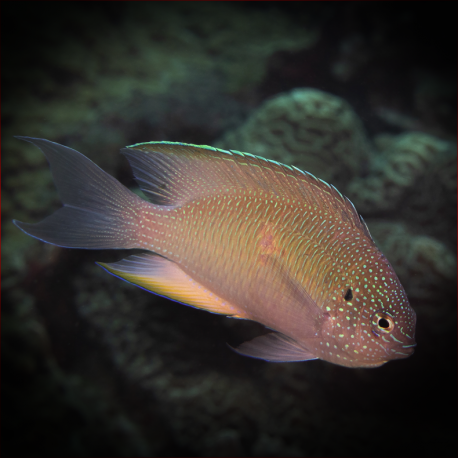More info
Datasheet
| Minimum Tank Size | 113 litres / 29.85 US gallons |
| Maximum Size | 7.6cm / 2.99inches |
| Reef Compatible | Yes |
| Temperament | Semi-aggressive |
| Care Description | Easy |
| Specific Gravity | 1.020-1.025 |
| Carbonate Hardness | 8-12 |
| pH | 8.1-8.4 |
General Description
The Biota Sapphire Damselfish, scientifically known as Pomacentrus pavo, is commonly referred to as the Sapphire Damselfish due to its striking blue coloration. The males sport a vibrant blue hue with an orange tail, while the females are uniformly blue. This species is known for its hardy nature and active behavior, making it a popular choice for saltwater aquarium enthusiasts.
Aquarium Suitability
The Biota Sapphire Damselfish is considered easy to care for, making it suitable for beginner hobbyists. It can be housed in aquariums of at least 113 liters (30 gallons) and is generally compatible with a variety of tank mates. However, as the fish matures, it may exhibit more aggressive tendencies, especially towards other fish species, requiring careful consideration when selecting tank mates.
Demands, Care, and Hardiness
This species has relatively low demands, thriving in marine aquariums with stable water conditions. The Biota Sapphire Damselfish prefers a pH range of 8.1-8.4, a specific gravity of 1.020-1.025, and a carbonate hardness (KH) of 8-12. Regular monitoring and maintenance of these parameters are crucial for the well-being of the fish.
Reef Suitability
The Sapphire Damselfish is reef-compatible, making it an excellent addition to reef tank setups. Its semi-aggressive temperament may pose a slight risk to more passive reef inhabitants, so careful observation is recommended when introducing it to a reef environment.
Aquarium Setup
When setting up an aquarium for the Biota Sapphire Damselfish, it is essential to provide ample hiding places to mitigate potential territorial aggression. Incorporating caves, rock formations, and live plants can help create a dynamic and stimulating environment for these active swimmers.
Behaviour
The Sapphire Damselfish is known for its social behavior and territorial tendencies. While it is less aggressive compared to other damselfish species, it may still exhibit aggression, especially towards conspecifics. Providing multiple hiding spots within the aquarium can help reduce territorial disputes among tank mates.
Feeding and Diet
As an omnivorous species, the Biota Sapphire Damselfish thrives on a varied diet consisting of flaked and frozen foods, as well as herbivore preparations. Offering a balanced diet rich in essential nutrients is essential for maintaining the fish's health and vibrant coloration.
Dimorphism and Captive Reproduction
The distinctive color differences between male and female Sapphire Damselfish make them easily distinguishable. Captive breeding of this species is relatively rare in home aquariums, with most specimens being sourced from wild populations.
Habitat and Distribution
In the wild, the Sapphire Damselfish is commonly found inhabiting reef environments across various regions. These fish are known to establish territories within coral reefs, where they can seek shelter in crevices and exhibit color-changing behavior as a defense mechanism against perceived threats.

